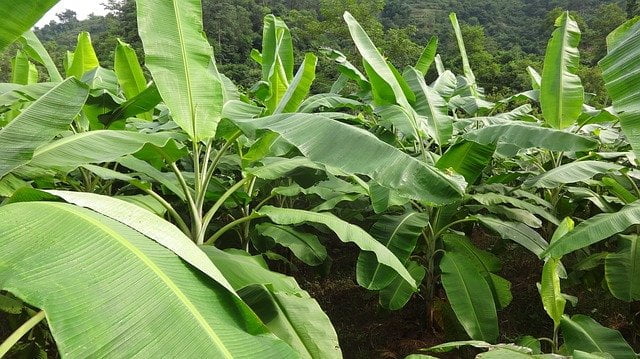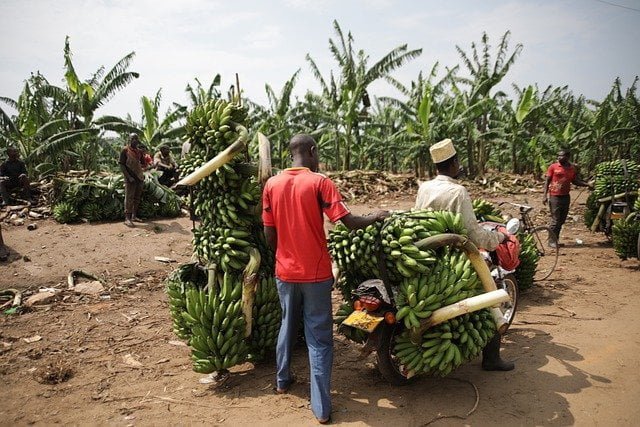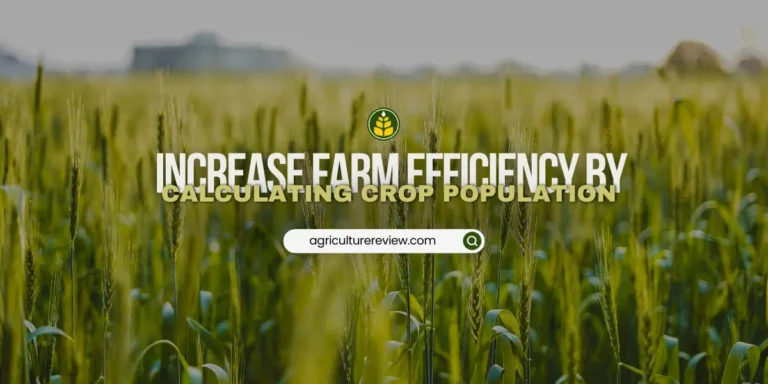केले की खेती पर यह मार्गदर्शिका आपको केले की खेती की पूरी प्रक्रिया को समझने में मदद करेगी। इसके अलावा, मिट्टी की आवश्यकताओं, जलवायु और तापमान, खेत की तैयारी, सिंचाई, उर्वरक आदि के बारे में जानें।
केले की खेती करना श्रमसाध्य है। इसलिए, यह रोजगार पैदा करने का एक स्रोत है। केले की खेती का अभ्यास करने से आपको पूरे साल जल्दी रिटर्न और लगातार आय मिल सकती है।
Table of Contents
परिचय
केला वानस्पतिक रूप से एक बेरी है, लेकिन इसे खाद्य फल माना जाता है। यह अत्यधिक पौष्टिक फल है। एक पके केले में 110 कैलोरी, 28 ग्राम कार्बोहाइड्रेट, 15 ग्राम प्राकृतिक चीनी, 3 ग्राम फाइबर, 450 मिलीग्राम पोटेशियम होता है।
दुनिया भर में इसकी खेती बड़े पैमाने पर की जाती है। केले का उपयोग चिप्स, प्यूरी, पाउडर, जैम, सॉस, सिरका, उर्वरक, वाइन, आदि बनाने के लिए किया जाता है। इसके अलावा लोग पके केले को इसके पौष्टिक मूल्य और स्वाद के लिए खाना पसंद करते हैं। इसलिए बाजार में मांग तेजी से बढ़ रही है।
यूरोपीय संघ केले का सबसे बड़ा आयातक है। यह केले के कुल वैश्विक आयात का लगभग 32% आयात करता है। संयुक्त राज्य अमेरिका दूसरा सबसे बड़ा आयातक है जिसके बाद रूसी संघ, जापान और चीन हैं।
स्रोत: businessdiary.com
वानस्पतिक वर्गीकरण
वानस्पतिक नाम: मूसा एक्युमिनाटा कोला या मूसा बालबिसियाना कोला
परिवार: मुसासी।
गण: जिंजीबेरालेस।
क्लास: लिलियोप्सिडा।
डिवीजन: मैग्नोलियोफाइटा।
गुणसूत्र संख्या: 33 (2n = 33)
स्रोत: plants.usda.gov
केले की उत्पत्ति
वैज्ञानिकों और शोधकर्ताओं का मानना है कि दक्षिण पूर्व एशिया और दक्षिण प्रशांत केले का मूल है। इसकी उत्पत्ति लगभग 8000 से 5000 ई.पू. तक हुई। बाद में अरब विजेता पश्चिम में केले लाए और दुनिया भर में इसकी खेती शुरू हुई।
स्रोत: maikfruitfair.org
क्षेत्र और उत्पादन
विश्व में केले का कुल उत्पादन लगभग 114 मिलियन टन (2017) पाया गया है। भारत केले का अग्रणी उत्पादक है, यह सालाना 29 मिलियन टन केले का उत्पादन करता है। अन्य प्रमुख केला उत्पादक देश चीन, फिलीपींस, ब्राजील, इक्वाडोर, इंडोनेशिया, कोस्टा रिका, मैक्सिको आदि हैं।
विश्व स्तर पर 5.6 मिलियन हेक्टेयर भूमि केले की खेती के लिए समर्पित है। केले की औसत उपज अलग-अलग देशों और किस्मों में भिन्न हो सकती है। आम तौर पर औसत उपज लगभग 40 से 50 टन प्रति हेक्टेयर है।
स्रोत: www.fao.org
केले की खेती गाइड

केले की खेती में सफल होने के लिए आपको सफल कृषि उद्यम के लिए महत्वपूर्ण पहलुओं के बारे में जानना होगा। ज्ञान की कमी और खराब प्रथाओं के परिणामस्वरूप कम उपज होती है। इसलिए, मिट्टी के प्रकार, तापमान और जलवायु, खेत की तैयारी, सिंचाई, उर्वरक आदि के बारे में जानने से उपज में वृद्धि सुनिश्चित करने में मदद मिलती है।
मिट्टी की आवश्यकता
के अनुसार, आप केले की खेती खराब से उत्तम प्रकार की मिट्टी में कर सकते हैं। लेकिन, अच्छी जल निकासी, गहरी, समृद्ध दोमट और मिट्टी सबसे अच्छी होती है केले उगाने के लिए। इसके अलावा यदि मिट्टी में पर्याप्त उर्वरता और नमी धारण क्षमता है तो यह काफी अद्भुत है।
केले उगाने के लिए 6 से 7.5 pH की सीमा में मिट्टी का पीएच सबसे अधिक पसंद किया जाता है। हालांकि, खराब जल निकासी वाली मिट्टी या खराब मिट्टी की उर्वरता वाली खराब वातित मिट्टी में केले उगाने से बचें। साथ ही ऐसी मिट्टी में केले उगाने से बचें जो बहुत भारी हो, या खारी हो, या चूनेदार हो।
केले की खेती शुरू करने से पहले अपनी मिट्टी की जांच करा लें। यदि मिट्टी बहुत अधिक अम्लीय या क्षारीय नहीं है, और पर्याप्त मात्रा में नाइट्रोजन, फास्फोरस और पोटेशियम के साथ कार्बनिक पदार्थों से भरपूर है तो यह केला उगाने के लिए आदर्श है।
जलवायु और तापमान
केले की खेती उष्णकटिबंधीय से उपोष्णकटिबंधीय जलवायु में आसानी से की जा सकती है। आप 70 से 75% सापेक्षिक आर्द्रता और तापमान 15 से 35 डिग्री सेल्सियस वाले क्षेत्रों में केले की खेती शुरू कर सकते हैं। 12 डिग्री सेल्सियस से नीचे का तापमान ठंड लगने का कारण बनता है और 85 किलोमीटर प्रति घंटे से ऊपर हवा का वेग फसल को नुकसान पहुंचा सकता है।
650 से 750 मिमी की औसत वर्षा मानसून के दौरान मजबूत पौधों की वृद्धि के लिए आवश्यक है। आप केले को समुद्र तल से औसत समुद्र तल से 2000 मीटर की ऊंचाई तक उगा सकते हैं। लेकिन अधिक ऊंचाई पर, आप केवल उन किस्मों को उगा सकते हैं जो पहाड़ी क्षेत्रों में बढ़ने के लिए अनुकूल हैं।
रोपण सामग्री
गेहूं या मक्का जैसी अन्य फसलों के विपरीत, आप बीज से केले का प्रचार नहीं कर सकते। केले के प्रवर्धन के लिए दो विकल्प उपलब्ध हैं। पहला सकर्स से है और दूसरा टिशू कल्चर सीडलिंग से है।
केवल 30% किसान केले की खेती के लिए ऊतक संवर्धित पौध का उपयोग कर रहे हैं। लेकिन, टिश्यू कल्चर से उगाए जाने वाले केले के पौधे की क्षमता अधिक होती है। हालांकि, बाकी की तरह 70% आप अच्छी तरह से विकसित प्रकंद सक्रिय रूप से बढ़ने वाली शंक्वाकार कली वाले सकर का भी उपयोग कर सकते हैं। रोपण सामग्री का वजन लगभग 450 से 700 ग्राम होना चाहिए।
लेकिन मुख्य समस्याएं जो सकरों का उपयोग करने में उत्पन्न होती हैं, वे हैं रोगजनकों से संक्रमण, सकर की उम्र और आकार में भिन्नता के कारण असमान फसल वृद्धि। इसके अलावा किसान को फसल के प्रबंधन और लंबे समय तक कटाई में भी समस्या का सामना करना पड़ता है।
यही कारण हैं कि सरकारी संगठन किसानों को टिश्यू कल्चर केले के पौधों का उपयोग करने का सुझाव देते हैं। ये जल्दी परिपक्व हो जाते हैं, किसी भी प्रकार के कीट और रोग आदि से मुक्त होते हैं। अत्यधिक गर्म और ठंडे मौसम को छोड़कर आप इन्हें साल में कभी भी लगा सकते हैं।
एक और फायदा यह है कि 95 से 98% टिशू कल्चर से उगाए जाने वाले पौधे केले के गुच्छे लगते हैं। इससे उपज में वृद्धि होती है और पूंजी निवेश में कमी आती है।
रोपण समय
आम तौर पर, आप मई से जून या सितंबर से अक्टूबर के दौरान रोपण शुरू कर सकते हैं। हालाँकि, आप पूरे साल केले लगा सकते हैं लेकिन अत्यधिक सर्दी और गर्मी के मौसम में रोपण से बचें। सकर्स लगाने से पहले आप सकर्स का पूर्व उपचार कर सकते हैं।
यह अच्छे स्वास्थ्य और सकर्स के विकास में मदद करेगा। कॉर्म को 0.1% एमिसन के घोल में 5 मिनट के लिए डुबोएं। इससे केले में मुरझान रोग से बचाव होगा। इसके अलावा, आप कॉर्म को मोनोक्रोटोफॉस के 0.75% घोल में भी डुबा सकते हैं। छाया में डुबाने के बाद रोपण से पहले 24 घंटे तक सुखाएं।
रोपण प्रणाली
केले की रोपाई के लिए मुख्यतः चार प्रणालियाँ हैं। ये एकल पंक्ति प्रणाली, युग्मित पंक्ति प्रणाली, वर्ग प्रणाली और त्रिकोणीय प्रणाली हैं। प्रत्येक प्रणाली के अपने फायदे हैं। आप स्थान और भू-भाग के आधार पर उनमें से किसी एक का चयन कर सकते हैं।
| प्रणाली | रोपण दूरी | पौधे प्रति हेक्टेयर |
|---|---|---|
| जोड़ीदार पंक्ति प्रणाली | 1.2 x 1.2 x 2.0 मीटर | 5200 |
| स्क्वायर सिस्टम | 1.8 x 1.8 मीटर | 3025 |
| त्रिकोणीय प्रणाली | 1.5 x 1.8 मीटर | 3630 |
सिंगल रो सिस्टम
एकल पंक्ति प्रणाली में, हम पंक्ति के भीतर निकट दूरी लेकिन पंक्ति के बीच व्यापक दूरी बनाए रखते हैं। इस रोपण के बाद इसके पेशेवरों और विपक्ष हैं। प्रति हेक्टेयर पौधों की संख्या कम होने से उपज कम हो जाती है। लेकिन, अगर आप इस प्रणाली का पालन करते हैं तो फंगल इंफेक्शन होने की संभावना कम हो जाती है।
इस प्रणाली का पालन करने से कैनोपी लगाने के लिए अच्छे वातन में मदद मिलती है। इसलिए गीली पत्तियाँ जल्दी सूख जाती हैं।
जोड़ीदार पंक्ति प्रणाली
युग्मित पंक्ति प्रणाली में, हम 0.90 से 1.20 मीटर दो पंक्तियों के बीच की दूरी और 1.2 से 2 मीटर पौधे से पौधे के बीच की दूरी बनाए रखते हैं। आप इस प्रणाली का पालन करके आसानी से इंटरकल्चरल ऑपरेशन कर सकते हैं।
यदि आप ड्रिप सिंचाई पद्धति का उपयोग करना चाहते हैं तो इस प्रणाली का पालन करने से ड्रिप सिंचाई की लागत कम करने में मदद मिलेगी।
स्क्वायर रो सिस्टम
This is one of the most common system of planting used for banana farming. You should maintain (1.8 x 1.8)metres spacing between row to row और plant to plant. If you practice this system then it will allow you to add more short lived companion filler trees in the space left between each square.
त्रिकोणीय प्रणाली
If you want to grow tissue cultured banana then this system of planting is best for you. Maintain row to row distance of 1.5 metres और plant to plant distance of 1.8 metres. Although this is similar to square system but there is a difference.
In this system, plant in even numbered rows are midway between those in the odd rows. They are not planted opposite to them. Moreover, the distance between two adjacent plant in a row is equal to the perpendicular distance between any two adjacent rows.
रोपण विधि
आप मुख्य रूप से इन तीन विधियों में से किसी एक का पालन करके केले के सकर या टिश्यू कल्चर वाले पौधे लगा सकते हैं। रोपण प्रणालियों की तरह, केले के रोपण के तरीकों के अपने फायदे और नुकसान हैं। आप अपनी पसंद के अनुसार इनमें से किसी एक का चयन और अभ्यास कर सकते हैं।
गड्ढे की विधि
For practicing this method of plantation, you have to dig pits of size 60 x 60 x 60 centimetres. Fill the pit with the mixture of soil, sand, and Farm Yard Manure. The ratio should be 1:1:1. Plant the sucker in the centre of the pit and compact the soil around the pit.
However, this method is very labour intensive and expensive. But if you follow this method then no earthing up is required. As we do planting at the required depth.
फरो विधि
For practicing this method of plantation, after field preparation, you have to make furrows. You can either do this manually or with the help of a ridger. Plant the suckers at the required spacing. Compact the suckers by applying Farm Yard Manure and soil around the suckers.
You can practice furrow method in annual planting system. But you need to practice earthing up frequently. This helps in covering of exposed rhizomes.
खाई रोपण
This planting system is practiced in wet lands. You can prepare the field just like paddy. You can use plenty of water and gauge wheel. Later on water is drained from the field. You can plant the suckers directly in the wet field by pressing them.
After 7 days open 15 centimetres deep trenches both ways. Maintain 4 to 6 plants in each block. Deep the trenches every month by 20 to 25 centimetres. Keep doing this seedlings reaches 1 to 3 leaves. Keep cleaning the trenches within 2 months.
During rainy seasons, you can use some of the trenches to remove excess water from the field.
खेत की तैयारी
If you are practicing banana farming in wetlands then no preparation is required. But if you are practicing single row system then 2 to 4 ploughings are required. However, before planting banana, you can grow green manuring crops. These crops are Sesbania और cowpea.
Plough the field 4 to 6 times and leave the field for 14 days. You can break the clods and bring soil to the finer tilt with the help of rotovator or harrow. During field preparation of field you can add Farm Yard Manure @ 50 tonnes per hectare.
You can level the field by passing blade harrow या laser leveller. Using laser leveller is highly beneficial. It can be used to level wide range of terrain and can also help in conservation of irrigation water. If you are preparing pits for banana plantation then you can follow the following process.
You can dig a pit of (45 x 45 x 45) centimetres. Add 10 किलोग्राम of well decomposed Farm Yard Manure, 250 grams of Neem cake, and 20 grams of carbofuran. Mix this with top layer soil that you took out to dig the pit. Fill the pit with this mixture and leave it open to solar radiation.
If your field has nematodes, then you can also add fumigants or nematicides. If you want to grow organically then you can use पंचगव्य या jeevamrit in your field.
सिंचाई
Banana plant is a evergreen, shallow rooted plant, hence it requires large quantity of water. Banana crop requires on an average 1,800 to 2000 mm of water annually. During summer you can irrigate the field in an interval of 4 to 5 days. But during winters you can irrigate the field at an interval of 7 to 8 days.
You should avoid irrigating field during rainy season. As excess water can cause root zone congestion. This can result in poor plant health. In total 70 to 75 irrigation should be provided to the crop. If you want to increase the water use efficiency then you can adopt drip irrigation practices in your field.
Drip irrigation system helps in improving crop yield by 23 to 32% and also helps in saving 58% of the water. You can give drip irrigation @ 15 litres of water per plant per day from planting to the fourth month.
From fifth month to shooting stage apply 20 litres of water per plant per day. From shooting stage to 15 days prior to harvesting apply 25 litres of water per plant per day.
खाद
Banana is a heavy feeder crop. A single plant of banana requires 10 to 20 Kilograms of Farm Yard Manure, 200 to 250 grams Nitrogen, 60 to 70 grams Phosphorus, and 300 grams Potassium. However, banana crop requires 7 to 8 Kilograms of Nitrogen, 0.7 to 1.5 Kilograms of Phosphorus, and 17 to 20 Kilograms of Potassium per metric ton yield.
You can apply 100 grams of नाइट्रोजन in 3 split dozes. You can apply as top dressing in the interval of 30, 60, and 120 days after planting. At the time of planting apply 100 grams of Potassium and 40 grams Phosphorus.
You can also adopt fertigation to increase the yield and reduce the loss of nutrients from the soil. In fertigation you can apply water soluble fertilizers with the help of drip irrigation. Using fertigation method can increase yield by 25 to 30%. Moreover, it also helps in reduction of labour cost and time consumption.
To fulfil the micronutrients requirements you can apply 0.5% ZnSO4, 0.2% CuSO4, 0.2% FeSO4, and 0.1% H3BO3. You can apply them as foliar spray at an interval of 3, 5, and 7 months after planting. This also helps in improving yield.
If you want to go completely organic then you can use waste decomposer solution to increase crop yield.
कीट और रोग
Pests like root stock or rhizome weevil, stem borer, thrips, banana beetle, banana aphids, nematodes etc. can attack on your plant. Diseases like anthracnose, panama wilt, leaf spot, shoot rot, viral diseases, etc. can destroy your crop.
You can save your plant from diseases and pests by using neemastra या aagneyastra periodically.
Intercultural Operation
For successful banana farming you should practice the following intercultural practice. These practices are de-suckering, propping, mulching, Pruning, Mattacking, Earthing Up, Bunch Covering, Bunch Thinning, Denavelling, Peduncle wrapping, wind break, etc.
Sponsered Product: Steel Multi Star Culti-Weeder
De-suckering
You have to keep removing unwanted and surplus suckers. You can either cut the sucker from the ground level. Or you can destroy the heart of the suckers. However, you can also pour kerosene in the heart of sucker. This will also help to destroy unwanted sucker. Only one sucker is retained per plant.
Propping
When bunch emerges then pseudo-stem requires support. You can provide the support from props. For this you can use bamboo poles. Carefully give support by bamboo poles.
मल्चिंग
Mulching helps in increasing the nutrients and water use efficiency. According to TNAU, mulching also helps in increasing yield by 30 to 40%.
छंटाई
Time to time pruning of dead and decaying leaves ensures healthy growth of the plant. For maximum bunch development leave at least 6 to 8 healthy leaves on the plant. But, keep removing the rest of unhealthy leaves.
पौधों में मिट्टी चढ़ाना
For formation of better root system and support to the base earthing up is necessary. You can practice earthing up during rainy seasons. This will help to avoid water logging conditions in the field.
Bunch Covering & Thinning
You can cover the bunches with gunny bags or perforated polythene bags. This helps in improving yield by 15 to 20%. For bunch thinning you should remove 1 to 2 small bottom hands from the bunch. Keep 7 to 8 hands for healthy growth. This will help in uniform bunch development.
Denavelling
After the completion of female phase you have to remove the male bud from the bottom. This practice helps in promoting fruit development in the bunch.
Peduncle Wrapping
Peduncle is the bridge between bunch and the plant. It helps in providing nutrients, photosynthates, and water to the developing bunch. Hence, you need to protect it from any kind of injury that can be either from bright sunshine or bacteria or fungi.
For this purpose you can wrap peduncle with either flag leaves or dry banana leaves.
Tagging
You should definitely tag the bunches with respect to the week of emergence and covering.
Wind Break
High pressure wind can cause serious damage to the banana crop. To prevent your crop from wind you can plant Sesbania egyptifolia across the border of the field. Plant them in east – west direction.
फसल की कटाई
You can start harvesting banana at the physiological maturity stage. This will ensure better post-harvest quality of the fruit. You can harvest with the help of sharp sickle. Cut 30 centimetres above the first hand. Generally after the opening of the first hand, it takes 100 to 110 for the bunch to be ready for harvesting.
उपज
According to nhb.gov.in under flood or furrow irrigation system the average yield is around 46.40 tonnes per hectare. But, under drip irrigation it is about 69.72 tonnes per hectare.
सामान्य प्रश्न
Banana farming is a type of plantation agriculture system in which banana is cultivated intensively on a large scale for commercial purposes.
लेखक का नोट
I guess you are now clear on banana farming. If you have any idea, suggestions or query then you can leave your comment below. You can also connect with एग्रीकल्चर रिव्यू on Facebook, Instagram, and Pinterest.







Thank you for a comprehensive write up on banana farming.What can i use in place of jaggery as where i am it is not available? Is molasses OK?
Hi,
You can use sugarcane juice instead of Jaggery to prepare the solution.
I hope this will help!